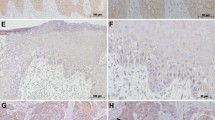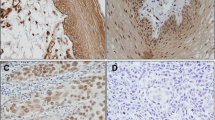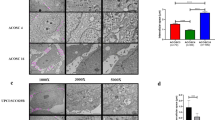Abstract
Objective
The purpose of this study was to investigate gene/protein expression alterations of intercellular connections’ components in oral leukoplakia (OLs) and squamous-cell carcinoma (OSCCs).
Materials and methods
Expression of desmogleins-2,3 (Dsg2/Dsg3), E-cadherin, and their cytoplasmic ligand, β/γ-catenins were quantitatively assessed in HSC-3 cells growing as monolayer cultures (ML)/multicellular aggregates (MCAs), using RT-PCR/Western blot, whereas their localization was detected by immunofluorescence. Furthermore, their expression was semi-quantitatively investigated in tissues from 25 OLs/25 OSCCs, using automated immunohistochemistry.
Results
The steady-state levels of Dsg3 RNA transcripts increased as HSC-3 cells enter their exponential phase of growth, before a dramatic decrease to be observed as cells reached their plateau phase especially in MCAs. Upon the same period of time, Dsg2 levels have been increased. The expression of γ-catenin but not that of β-catenin was increased after 48 h in both MLs and MCAs. In clinical samples, Dsg3, Ε-cadherin, β/γ-catenin down-regulation was observed to be associated with the grade of OLs-dysplasia and OSCCs. Importantly, a membrane-to-cytoplasmic switch of expression and strong perinuclear aggregation of Dsg3/γ-catenin was seen in both HSC-3 cells and OLs/OSCCs.
Conclusions
The altered expression of Dsg3/γ-catenin and E-cadherin/β-catenin, in vitro and in ODs/OSCC imply their involvement in growth regulation and phenotype of dysplastic/malignant oral epithelial cells, contributing to the better understanding of epithelial dysplasia and OSCCs.
Clinical relevance
The observed alterations of their expression suggest a role of Dsg3 and γ-catenin (additionally to E-cadherin/β-catenin) as biomarkers of malignant transformation risk of oral dysplasia and the biological behavior (aggressiveness) of oral cancer, respectively.






Similar content being viewed by others
References
Zhong X, Rescorla FJ (2012) Cell surface adhesion molecules and adhesion-initiated signaling: understanding of anoikis resistance mechanisms and therapeutic opportunities. Cell Signal 24:393–401
Takeichi M (1991) Cadherin cell adhesion receptors as a morphogenetic regulator. Science 251:1451–1455
Ziober BL, Silverman SS Jr, Kramer RH (2001) Adhesive mechanisms regulating invasion and metastasis in oral cancer. Crit Rev Oral Biol Med 12:499–510
Birchmeier W, Behrens J (1994) Cadherin expression in carcinomas: role in the formation of cell junctions and the prevention of invasiveness. Biochim Biophys Acta 1198:11–26
Chidgey M, Dawson C (2007) Desmosomes: a role in cancer. Br J Cancer 96:1783–1787
Tian X, Liu Z, Niu B, Zhang J, Tan TK, Lee SR et al (2011) E-cadherin/β-catenin complex and the epithelial barrier. J Biomed Biotechnol 2011:567305
Vizirianakis IS, Chen YQ, Kantak SS, Tsiftsoglou AS, Kramer RH (2002) Dominant-negative E-cadherin alters adhesion and reverses contact inhibition of growth in breast carcinoma cells. Int J Oncol 21:135–144
Rodriguez FJ, Lewis-Tuffin LJ, Anastasiadis PZ (2012) E-cadherin’s dark side: possible role in tumor progression. Biochim Biophys Acta 1826:23–31
Clevers H (2006) Wnt/beta-catenin signaling in development and disease. Cell 127:469–480
Ochiai A, Akimoto S, Kanai Y, Shibata T, Oyama T, Hirohashi S (1994) c-erbB-2 gene product associates with catenins in human cancer cells. Biochem Biophys Res Commun 205:73–78
Pece S, Gutkind JS (2000) Signaling from E-cadherins to the MAPK pathway by the recruitment and activation of epidermal growth factor receptors upon cell-cell contact formation. J Biol Chem 275:41227–41233
Garrod DR, Merritt AJ, Nie Z (2002) Desmosomal adhesion: structural basis, molecular mechanism and regulation (review). Mol Membr Biol 19:81–94
Harada H, Iwatsuki K, Ohtsuka M, Han GW, Kaneko F (1996) Abnormal desmoglein expression by squamous cell carcinoma cells. Acta Derm Venereol 76:417–420
Krunic AL, Garrod DR, Madani S, Buchanan MD, Clark RE (1998) Immunohistochemical staining for desmogleins 1 and 2 in keratinocytic neoplasms with squamous phenotype: actinic keratosis, keratoacanthoma and squamous cell carcinoma of the skin. Br J Cancer 77:1275–1279
Imai K, Kumagai S, Nakagawa K, Yamamoto E, Nakanishi I, Okada Y (1995) Immunolocalization of desmoglein and intermediate filaments in human oral squamous cell carcinomas. Head Neck 17:204–212
Chen YJ, Chang JT, Lee L, Wang HM, Liao CT, Chiu CC et al (2007) DSG3 is overexpressed in head neck cancer and is a potential molecular target for inhibition of oncogenesis. Oncogene 26:467–476
Chung CH, Parker JS, Karaca G, Wu J, Funkhouser WK, Moore D et al (2004) Molecular classification of head and neck squamous cell carcinomas using patterns of gene expression. Cancer Cell 5:489–500
Kurzen H, Münzing I, Hartschuh W (2003) Expression of desmosomal proteins in squamous cell carcinomas of the skin. J Cutan Pathol 30:621–630
Garrod D (2010) Desmosomes in vivo. Dermatol Res Pract 2010:212439
Windoffer R, Borchert-Stuhlträger M, Leube RE (2002) Desmosomes: interconnected calcium-dependent structures of remarkable stability with significant integral membrane protein turnover. J Cell Sci 115:1717–1732
Närkiö-Mäkelä M, Pukkila M, Lagerstedt E, Virtaniemi J, Pirinen R, Johansson R et al (2009) Reduced gamma-catenin expression and poor survival in oral squamous cell carcinoma. Arch Otolaryngol Head Neck Surg 135:1035–1040
Nagel JM, Kriegl L, Horst D, Engel J, Gautam S, Mantzoros CS et al (2010) γ-Catenin is an independent prognostic marker in early stage colorectal cancer. Int J Colorectal Dis 25:1301–1309
Rieger-Christ KM, Ng L, Hanley RS, Durrani O, Ma H, Yee AS et al (2005) Restoration of plakoglobin expression in bladder carcinoma cell lines suppresses cell migration and tumorigenic potential. Br J Cancer 92:2153–2159
Miravet S, Piedra J, Miró F, Itarte E, García de Herreros A, Duñach M (2002) The transcriptional factor Tcf-4 contains different binding sites for beta-catenin and plakoglobin. J Biol Chem 277:1884–1891
Hakimelahi S, Parker HR, Gilchrist AJ, Barry M, Li Z, Bleackley RC et al (2000) Plakoglobin regulates the expression of the anti-apoptotic protein BCL-2. J Biol Chem 275:10905–10911
Dusek RL, Godsel LM, Chen F, Strohecker AM, Getsios S, Harmon R et al (2007) Plakoglobin deficiency protects keratinocytes from apoptosis. J Invest Dermatol 127:792–801
Chidgey M, Dawson C (2007) Desmosomes: a role in cancer? Br J Cancer 96:1783–1787
Kantak SS, Kramer RH (1998) E-cadherin regulates anchorage-independent growth and survival in oral squamous cell carcinoma cells. J Biol Chem 273:16953–16961
Cirillo N, Boutros S (2008) Fate of desmoglein 3 and E-cadherin in anchorage-independent growth and adhesion to substrates of oral squamous carcinoma cells. J Stomatol Invest 2:41–51
Gornowicz-Porowska J, Bowszyc-Dmochowska M, Seraszek-Jaros A, Kaczmarek E, Dmochowski M (2011) Loss of correlation between intensities of desmoglein 2 and desmoglein 3 expression in basal cell carcinomas. Acta Dermatovenerol Croat 19:150–155
Lopes FF, da Costa Miguel MC, Pereira AL, da Cruz MC, de Almeida FR, Pinto LP et al (2009) Changes in immunoexpression of E-cadherin and beta-catenin in oral squamous cell carcinoma with and without nodal metastasis. Ann Diagn Pathol 13:22–29
Tanaka N, Odajima T, Ogi K, Ikeda T, Satoh M (2003) Expression of E-cadherin, alpha-catenin, and beta-catenin in the process of lymph node metastasis in oral squamous cell carcinoma. Br J Cancer 89:557–563
Wang L, Liu T, Wang Y, Cao L, Nishioka M, Aguirre RL et al (2007) Altered expression of desmocollin 3, desmoglein 3, and beta-catenin in oral squamous cell carcinoma: correlation with lymph node metastasis and cell proliferation. Virchows Arch 451:959–966
Lo Muzio L, Lo Russo L, Falaschini S, Ciavarella D, Pentenero M, Arduino P et al (2009) Beta- and gamma-catenin expression in oral dysplasia. Oral Oncol 45:501–504
Mahomed F, Altini M, Meer S (2007) Altered E-cadherin/beta-catenin expression in oral squamous carcinoma with and without nodal metastasis. Oral Dis 13:386–392
Ishida K, Ito S, Wada N, Deguchi H, Hata T, Hosoda M et al (2007) Nuclear localization of beta-catenin involved in precancerous change in oral leukoplakia. Mol Cancer 6:62
Sato K, Okazaki Y, Tonogi M, Tanaka Y, Yamane GY (2002) Expression of beta-catenin in rat oral epithelial dysplasia induced by 4-nitroquinoline 1-oxide. Oral Oncol 38:772–778
Williams HK, Sanders DS, Jankowski JA, Landini G, Brown AM (1998) Expression of cadherins and catenins in oral epithelial dysplasia and squamous cell carcinoma. J Oral Pathol Med 27:308–317
Santos-García A, Abad-Hernández MM, Fonseca-Sánchez E, Julián-González R, Galindo-Villardón P, Cruz-Hernández JJ et al (2006) E-cadherin, laminin and collagen IV expression in the evolution from dysplasia to oral squamous cell carcinoma. Med Oral Patol Oral Cir Bucal 11:E100–E105
Takayama T, Shiozaki H, Shibamoto S, Oka H, Kimura Y, Tamura S et al (1996) Beta-catenin expression in human cancers. Am J Pathol 148:39–46
Shinohara M, Hiraki A, Ikebe T, Nakamura S, Kurahara S, Shirasuna K et al (1998) Immunohistochemical study of desmosomes in oral squamous cell carcinoma: correlation with cytokeratin and E-cadherin staining, and with tumour behaviour. J Pathol 184:369–381
Hiraki A, Shinohara M, Ikebe T, Nakamura S, Kurahara S, Garrod DR (1996) Immunohistochemical staining of desmosomal components in oral squamous cell carcinomas and its association with tumour behaviour. Br J Cancer 73:1491–1497
Alazawi WO, Morris LS, Stanley MA, Garrod DR, Coleman N (2003) Altered expression of desmosomal components in high-grade squamous intraepithelial lesions of the cervix. Virchows Arch 443:51–56
Teh MT, Parkinson EK, Thurlow JK, Liu F, Fortune F, Wan H (2011) A molecular study of desmosomes identifies a desmoglein isoform switch in head and neck squamous cell carcinoma. J Oral Pathol Med 40:67–76
Yin T, Green KJ (2004) Regulation of desmosome assembly and adhesion. Semin Cell Dev Biol 15:665–677
Simcha I, Geiger B, Yehuda-Levenberg S, Salomon D, Ben-Ze'ev A (1996) Suppression of tumorigenicity by plakoglobin: an augmenting effect of N-cadherin. J Cell Biol 133:19–20
Papagerakis S, Shabana AH, Depondt J, Pibouin L, Blin-Wakkach C, Berdal A (2004) Altered plakoglobin expression at mRNA and protein levels correlates with clinical outcome in patients with oropharynx squamous carcinomas. Hum Pathol 35:75–85
Ueda G, Sunakawa H, Nakamori K, Shinya T, Tsuhako W, Tamura Y et al (2006) Aberrant expression of beta- and gamma-catenin is an independent prognostic marker in oral squamous cell carcinoma. Int J Oral Maxillofac Surg Apr 35:356–361
Fillies T, Buerger H, Gaertner C, August C, Brandt B, Joos U et al (2005) Catenin expression in T1/2 carcinomas of the floor of the mouth. Int J Oral Maxillofac Surg 34:907–911
Lin YC, Wu MY, Li DR, Wu XY, Zheng RM (2004) Prognostic and clinicopathological features of E-cadherin, alpha-catenin, beta-catenin, gamma-catenin and cyclin D1 expression in human esophageal squamous cell carcinoma. World J Gastroenterol 10:3235–3239
Yamada K, Jordan R, Mori M, Speight PM (1997) The relationship between E-cadherin expression, clinical stage and tumour differentiation in oral squamous cell carcinoma. Oral Dis 3:82–85
Behrens J (1999) Cadherins and catenins: role in signal transduction and tumor progression. Cancer Metastasis Rev 18:15–30
Andreadis D, Epivatianos A, Mireas G, Nomikos A, Poulopoulos A, Yiotakis J et al (2006) Immunohistochemical detection of E-cadherin in certain types of salivary gland tumours. J Laryngol Otol 120:298–304
Liu LK, Jiang XY, Zhou XX, Wang DM, Song XL, Jiang HB (2010) Upregulation of vimentin and aberrant expression of E-cadherin/beta-catenin complex in oral squamous cell carcinomas: correlation with the clinicopathological features and patient outcome. Mod Pathol 23:213–224
Kurtz KA, Hoffman HT, Zimmerman MB, Robinson RA (2006) Decreased E-cadherin but not beta-catenin expression is associated with vascular invasion and decreased survival in head and neck squamous carcinomas. Otolaryngol Head Neck Surg 134:142–146
Schipper JH, Unger A, Jahnke K (1994) E-cadherin as a functional marker of the differentiation and invasiveness of squamous cell carcinoma of the head and neck. Clin Otolaryngol Allied Sci 19:381–384
Mattijssen V, Peters HM, Schalkwijk L, Manni JJ, van 't Hof-Grootenboer B, De Mulder PH et al (1993) E-cadherin expression in head and neck squamous-cell carcinoma is associated with clinical outcome. Int J Cancer 55:580–585
Acknowledgments
We would like to thank Prof. Athanasios D. Dinopoulos and Mrs. Giannakopoulou Aggeliki (Department of Anatomy, School of Veterinary Medicine, Aristotle University of Thessaloniki) for help conducting immunofluorescence analysis, and Mrs. M. Kefala and Dr M. Tsopanomichalou (Department of Histopathology, Red Cross Hospital of Athens) for their technical assistance in immunochemistry.
Conflict of interest
The authors declare that they have no conflict of interest.
Author information
Authors and Affiliations
Corresponding author
Additional information
Marianthi Kyrodimou and Dimitrios Andreadis have equally contributed as first authors.
Electronic supplementary material
Below is the link to the electronic supplementary material.
ESM 1
(DOCX 40 kb)
Rights and permissions
About this article
Cite this article
Kyrodimou, M., Andreadis, D., Drougou, A. et al. Desmoglein-3/γ-catenin and E-cadherin/ß-catenin differential expression in oral leukoplakia and squamous cell carcinoma. Clin Oral Invest 18, 199–210 (2014). https://doi.org/10.1007/s00784-013-0937-z
Received:
Accepted:
Published:
Issue Date:
DOI: https://doi.org/10.1007/s00784-013-0937-z




